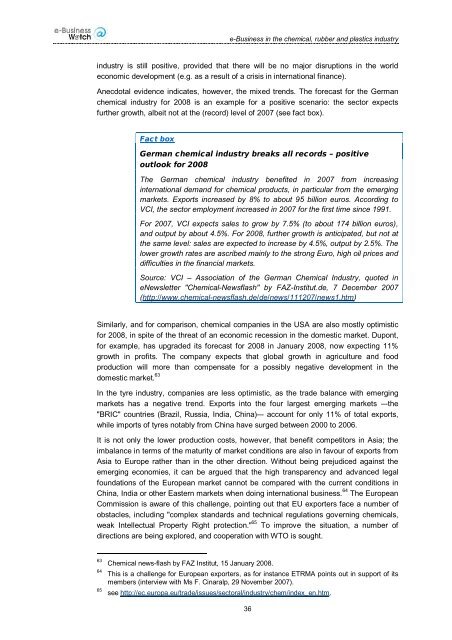Downloads - empirica
Downloads - empirica
Downloads - empirica
You also want an ePaper? Increase the reach of your titles
YUMPU automatically turns print PDFs into web optimized ePapers that Google loves.
e-Business in the chemical, rubber and plastics industryindustry is still positive, provided that there will be no major disruptions in the worldeconomic development (e.g. as a result of a crisis in international finance).Anecdotal evidence indicates, however, the mixed trends. The forecast for the Germanchemical industry for 2008 is an example for a positive scenario: the sector expectsfurther growth, albeit not at the (record) level of 2007 (see fact box).Fact boxGerman chemical industry breaks all records – positiveoutlook for 2008The German chemical industry benefited in 2007 from increasinginternational demand for chemical products, in particular from the emergingmarkets. Exports increased by 8% to about 95 billion euros. According toVCI, the sector employment increased in 2007 for the first time since 1991.For 2007, VCI expects sales to grow by 7.5% (to about 174 billion euros),and output by about 4.5%. For 2008, further growth is anticipated, but not atthe same level: sales are expected to increase by 4.5%, output by 2.5%. Thelower growth rates are ascribed mainly to the strong Euro, high oil prices anddifficulties in the financial markets.Source: VCI – Association of the German Chemical Industry, quoted ineNewsletter "Chemical-Newsflash" by FAZ-Institut.de, 7 December 2007(http://www.chemical-newsflash.de/de/news/111207/news1.htm)Similarly, and for comparison, chemical companies in the USA are also mostly optimisticfor 2008, in spite of the threat of an economic recession in the domestic market. Dupont,for example, has upgraded its forecast for 2008 in January 2008, now expecting 11%growth in profits. The company expects that global growth in agriculture and foodproduction will more than compensate for a possibly negative development in thedomestic market. 63In the tyre industry, companies are less optimistic, as the trade balance with emergingmarkets has a negative trend. Exports into the four largest emerging markets –-the"BRIC" countries (Brazil, Russia, India, China)–- account for only 11% of total exports,while imports of tyres notably from China have surged between 2000 to 2006.It is not only the lower production costs, however, that benefit competitors in Asia; theimbalance in terms of the maturity of market conditions are also in favour of exports fromAsia to Europe rather than in the other direction. Without being prejudiced against theemerging economies, it can be argued that the high transparency and advanced legalfoundations of the European market cannot be compared with the current conditions inChina, India or other Eastern markets when doing international business. 64 The EuropeanCommission is aware of this challenge, pointing out that EU exporters face a number ofobstacles, including "complex standards and technical regulations governing chemicals,weak Intellectual Property Right protection." 65 To improve the situation, a number ofdirections are being explored, and cooperation with WTO is sought.636465Chemical news-flash by FAZ Institut, 15 January 2008.This is a challenge for European exporters, as for instance ETRMA points out in support of itsmembers (interview with Ms F. Cinaralp, 29 November 2007).see http://ec.europa.eu/trade/issues/sectoral/industry/chem/index_en.htm.36
















